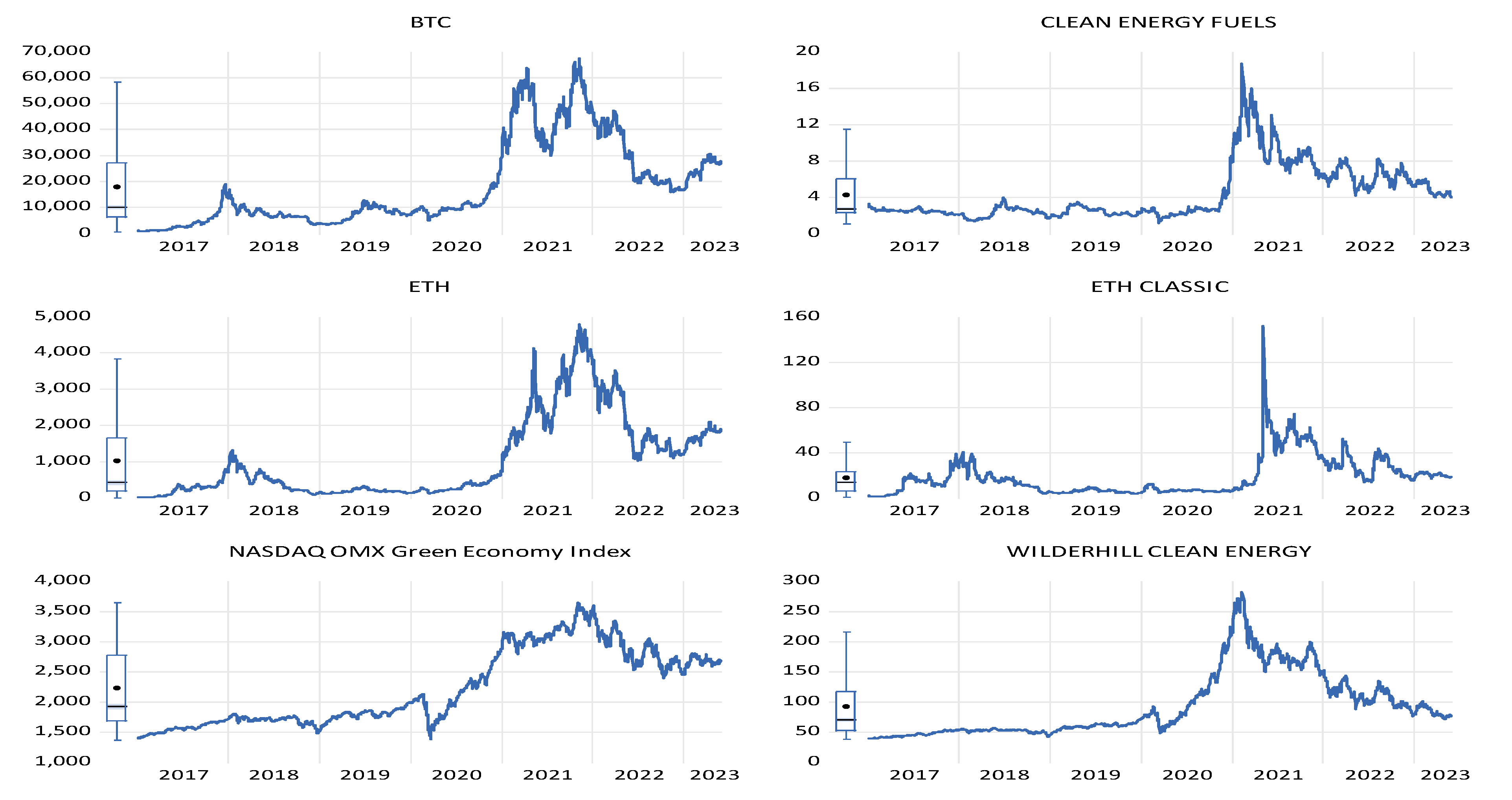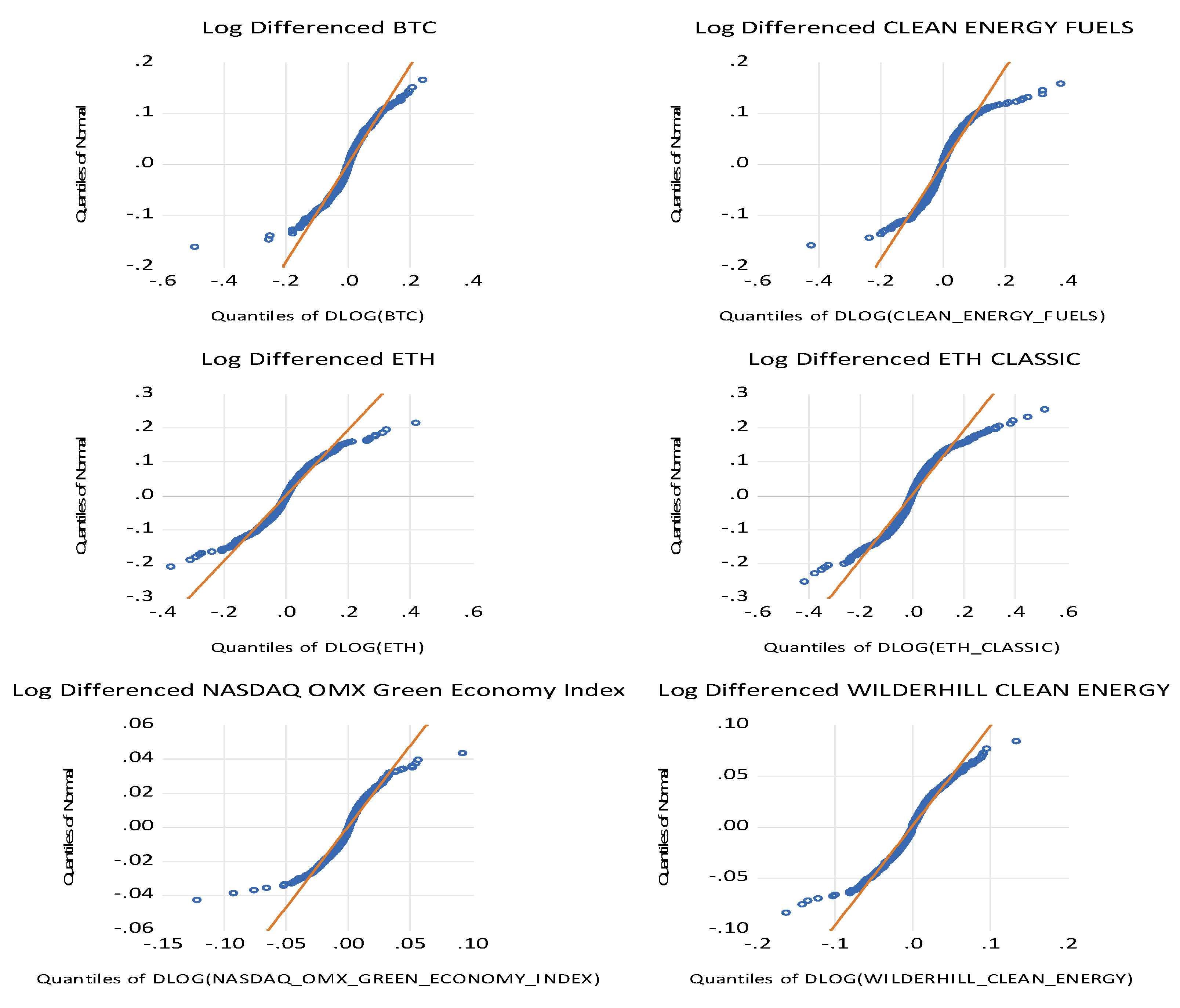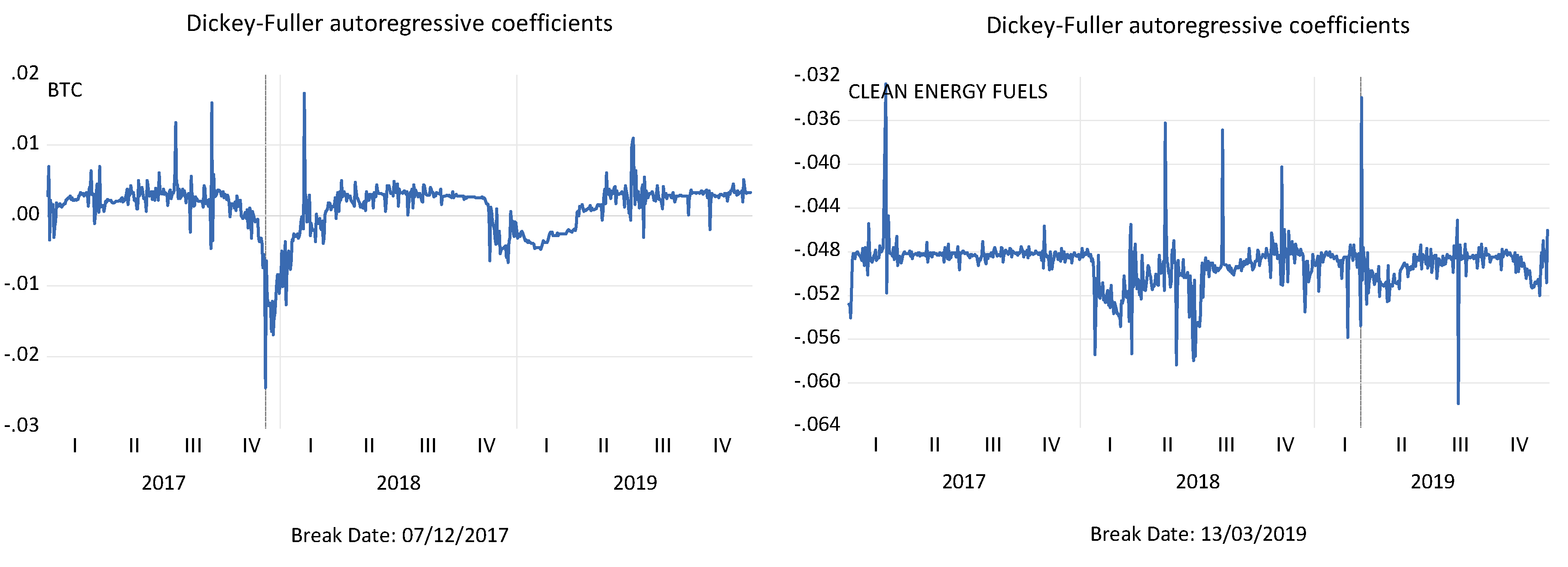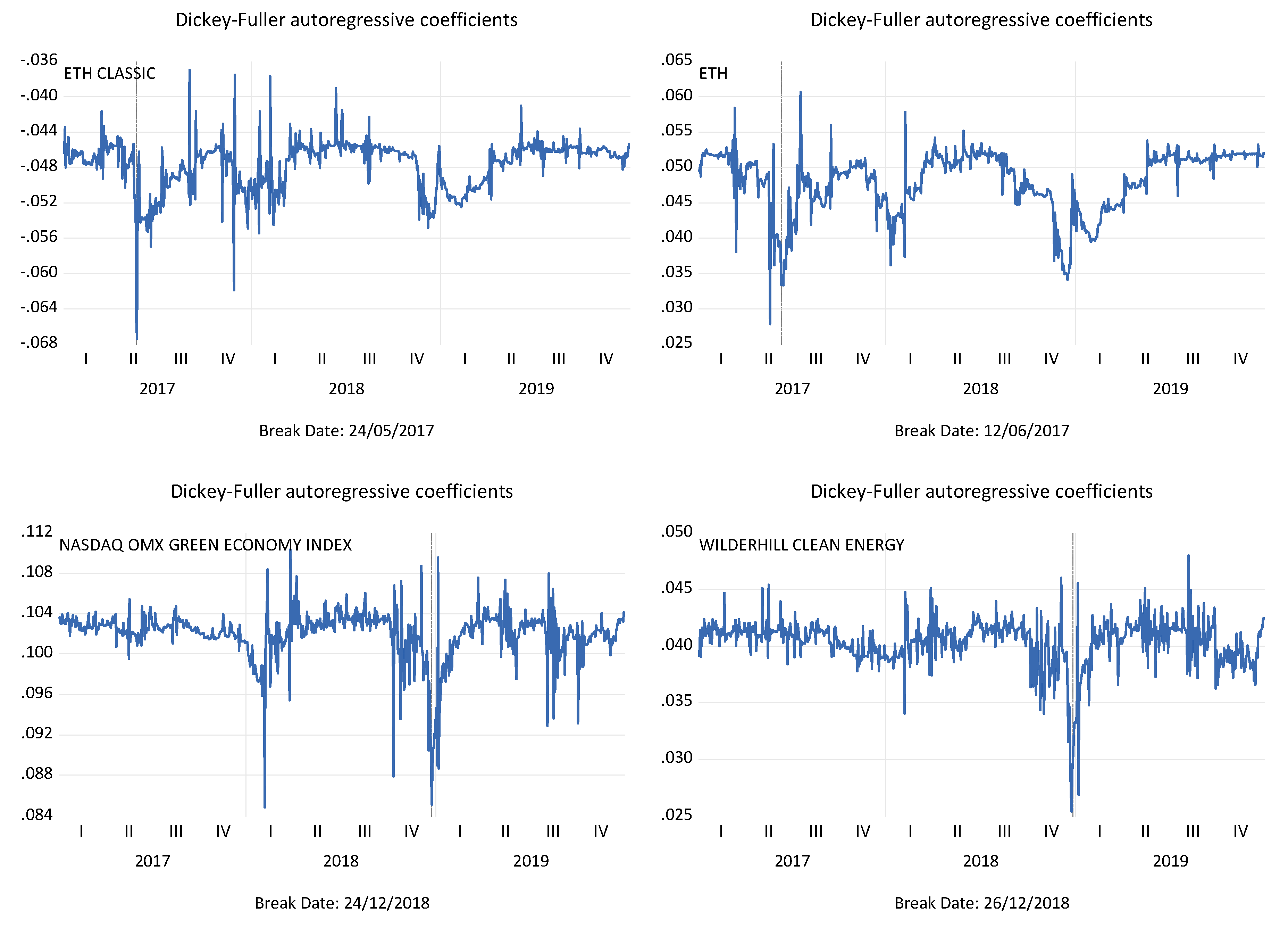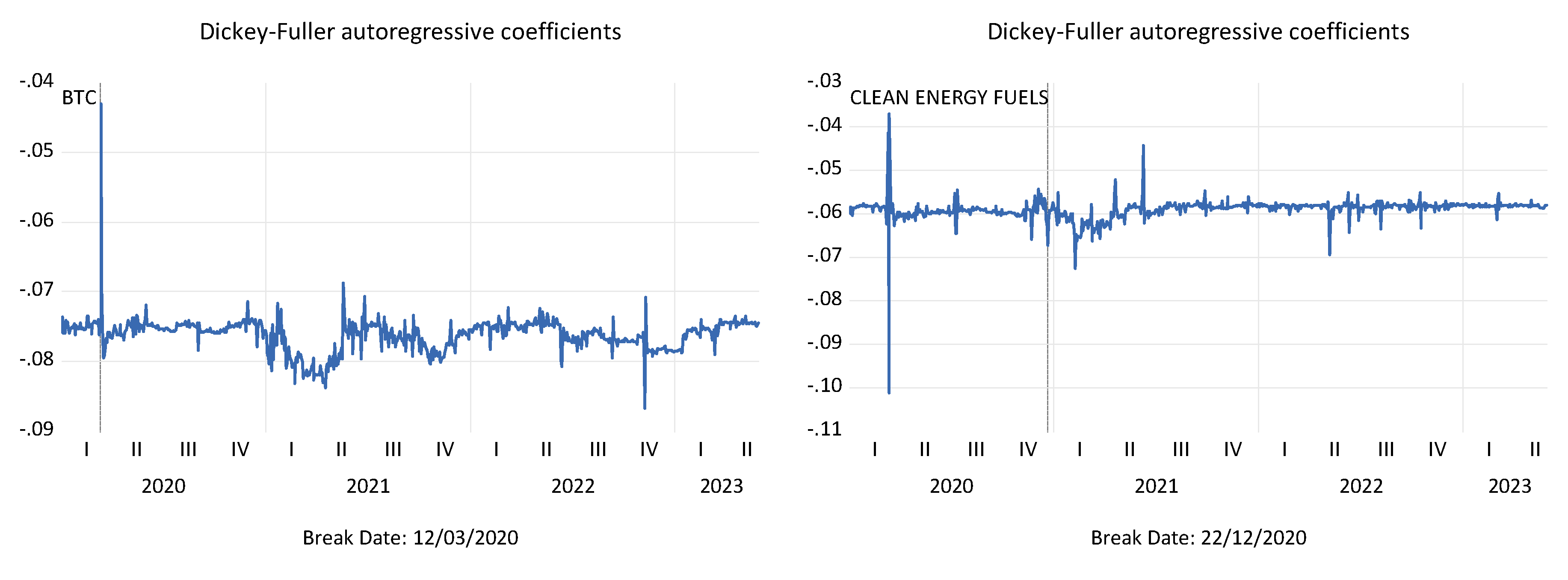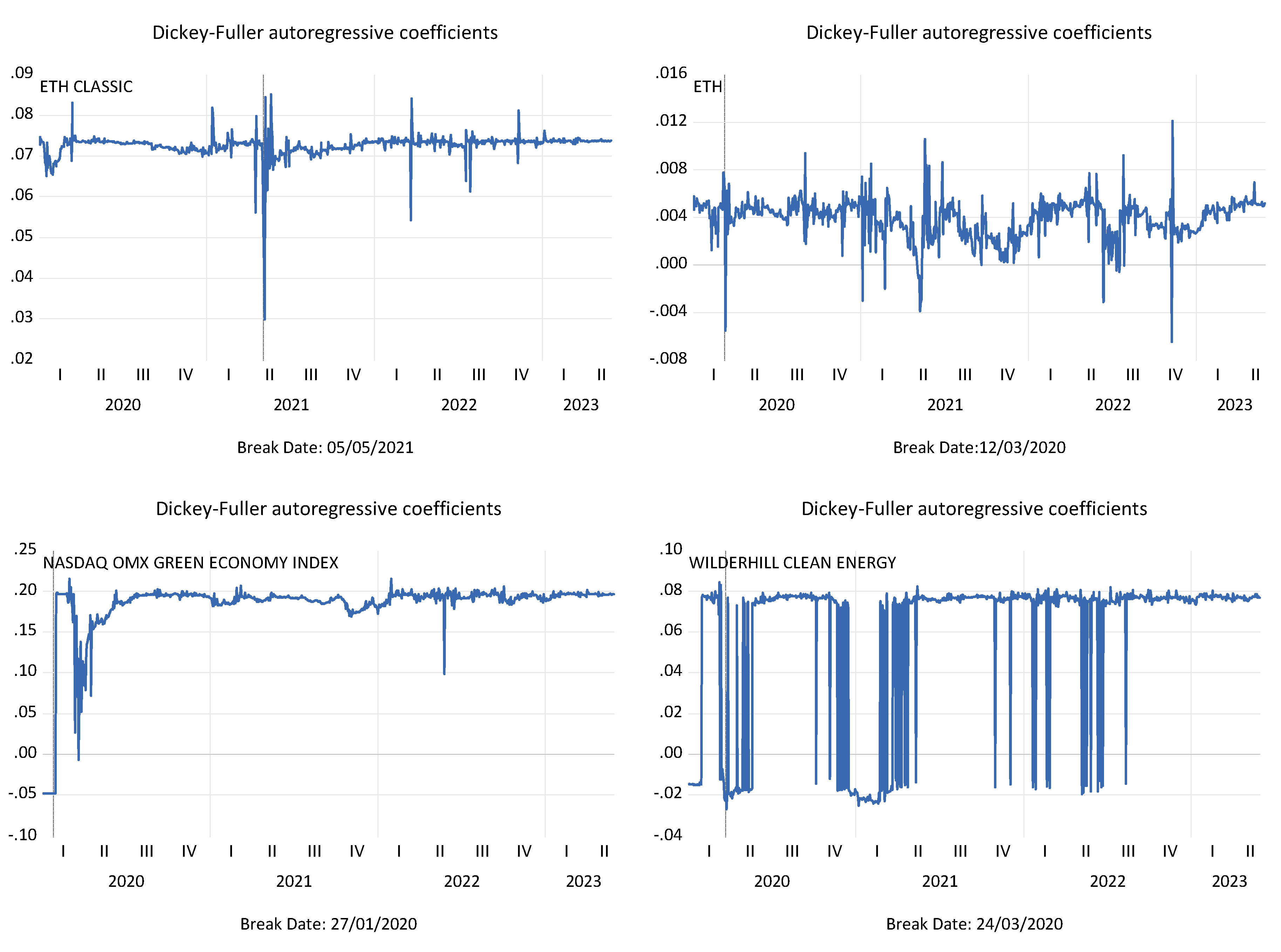The emergence of stock indexes that are focused on clean energy has brought about a significant transformation in the approach that investors adopt when assessing the progress of open-source firms that engage in the clean energy markets. These indexes have surfaced as fundamental instruments for the management of portfolios, producing valuable insights regarding the expansion and possibilities of investments in the sphere of clean energy. The efficiency of these indexes has been examined through different studies, including those conducted by [
17] and [
18], revealing their superiority over traditional stock and securities indexes. The study conducted by [
19] provides a more comprehensive outlook, in contrast to prior research that mainly examined the relationship between cryptocurrencies and traditional energy assets. The present research investigates the function of diverse assets, such as Bitcoin, gold, stocks, currencies, and energy commodities (namely, oil and natural gas), within the global network of volatility interconnection. The authors highlight the noteworthy influence of external investors' attention on the expansion of volatility within financial markets. [
20] have contributed to the understanding of the dynamic nature of asset interconnections through their research findings. The analysis reveals that Bitcoin, gold, exchanges, and natural gas are identified as transmitters of volatility, thereby indicating their influence on the transmission of market volatility. In contrast, crude oil and stock markets serve as indicators of vulnerability to external shocks and fluctuations.
Understanding the relationship among clean energy stock indexes, cryptocurrencies, and other assets could offer important insights for investors who aim to broaden their portfolios and capitalize on emerging opportunities. The investigation of trade-offs between clean and dirty energy stock indexes, as posited by [
21], holds significant importance for investors. This is because it enables them to evaluate the environmental impact of their investments, appraise financial performance, absorb policies and regulatory scenarios, and manage the energy transition. Clean energy stock indexes include companies engaged in sustainable technologies and renewable energy sources. The dirty energy stock indexes represent corporations involved in the extraction and use of fossil fuels, which have been identified as significant contributors to environmental deterioration. The adoption of trade-off analysis allows investors to efficiently match their portfolios with sustainability objectives, make well-informed financial decisions, anticipate regulatory adjustments, and take advantage of emerging opportunities in developing energy markets. This introduction sets the foundation for a more comprehensive investigation into the intricacies of these particular categories of assets and the potential implications for investors within the ever-changing financial and sustainable energy markets.
3.1. Studies Related to Research on Safe Haven Properties of Clean Energy Indexes and Cryptocurrencies
Many studies have explored the potential of clean energy as a safe haven from dirty energy. Several studies have been conducted in this area, including those by [
22,
23,
24]. [
22] proposed that an upsurge in the prices of traditional energy sources and the implementation of carbon pricing would encourage investments in clean energy firms. The study revealed that the stock prices of clean energy firms were subject to the impact of both oil prices and technology stock prices, thereby casting aspersions on the effectiveness of hedge and safe haven effects. Concurrently, [
23] conducted a study to examine the relationships between oil prices, clean energy stock prices, and technology stock prices. The researchers’ discoveries revealed a structural change during the latter part of 2007, which corresponded with a notable escalation in the cost of oil. The authors' research revealed a positive correlation between oil prices and clean energy prices subsequent to structural breaks, which contradicts previous studies and questions the impact of safe haven effects on portfolio diversification. [
25] conducted an analysis on the implications of shocks on safe haven properties and diversification of clean energy portfolios, specifically with regards to the WilderHill New Energy Global Innovation Index (NEX), technology shares (PSE), 4 energy subindexes of the Standard & Poor's Goldman Sachs Commodity Index (S&P-GSCI), 3 leading global stock indexes represented by the US and Europe, and the Dow Jones Islamic Market Index (DJIMI), as well as the USD-Euro exchange rate. The study conducted by the authors suggests that the addition of NEX to the energy portfolio results in improved diversification and risk mitigation advantages owing to the safe haven properties that it offers portfolio managers.
The safe haven characteristics of clean energy assets in comparison to those of dirty energy assets were investigated in subsequent studies by [
26,
27,
28]. The study conducted by [
26] was designed to examine the safe haven capacity of clean and green assets in relation to 2 dirty energy assets, namely disguised crude oil prices and energy ETFs. The research used daily data that extended from January 3, 2012, to November 29, 2019. The researcher's results provided evidence backing the idea of implementing a dynamic hedge strategy and suggested that clean energy initiatives were a more efficient hedge than green bonds, particularly in the context of crude oil. Similarly, [
29] conducted a study of the dynamic dependence structure between green bonds (UKs) and different global clean energy (CE) markets within the period of July 5, 2011, to February 24, 2020. The research findings indicate a significant dependence between the stock markets of the UK and CE. Furthermore, the authors have noted the occurrence of bidirectional shocks resulting from the occurrence of extreme low or high movements in the CE stock market. This observation implies that investors from the UK have successfully allocated their capital towards economic activities that produce low carbon emissions. The study conducted by [
28] examined the safe haven characteristics of clean energy indexes in relationship with two distinct types of cryptocurrencies, namely black, or "dirty," and green, or "clean," based on their energy consumption levels. The statistical analysis conducted indicated that clean energy failed to provide direct protection for any type of cryptocurrency. Nevertheless, it worked as a weak safe haven for both parties during periods of significant market downturns. The research indicates that during periods of heightened uncertainty, clean energy tended to act as a safer haven for cryptocurrencies with a higher carbon footprint (“dirty crypto”) as opposed to those with a lower carbon footprint (“clean crypto”).
Several studies were conducted by [
15,
16,
30] to investigate the extent of dependence between clean and green assets and cryptocurrencies. The primary objective of these studies was to ascertain whether clean assets exhibit safe-haven properties during times of market uncertainty on a global level. The authors, [
15], highlighted the existence of multiple dependence situations between bitcoin and green financial assets. The dependence structure was found to be mainly asymmetric and subject to shifting as time went by. Furthermore, the author's review of the efficiency of using bitcoin as a safe haven for green financial assets suggested that all clean energy green assets were effective in acting as safe havens against bitcoin. [
31] conducted a study that intended to examine the relationship between cryptocurrencies, green bonds, and other assets in terms of time and frequency. The findings of the study revealed significant relationships between markets, which cast doubt on the hypothesis of safe haven assets. Nevertheless, the main emphasis was on technology rather than clean energy indexes. The study conducted by [
16] used a TVP-VAR network connectivity model to examine the impact of variable-time shocks on investments in cryptocurrencies, green assets, and fossil fuels. The study revealed that the shocks between cryptocurrencies, green assets, and fossil fuels showed temporal fluctuations and exhibited higher levels during periods of crisis.
The issue of environmental and sustainability concerns stemming from the elevated energy consumption of cryptocurrencies has garnered the attention of policymakers and market participants, as evidenced by different research conducted by [
32,
33,
34]. The present study examined the potential of clean energy stock indexes to function as protective assets or safe havens in the context of dirty assets. [
35] conducted an investigation into the dependence of clean energy markets on dirty assets, namely oil and Bitcoin, during a period lasting from 2011 to 2019. The authors show a notable degree of integration in terms of spillover effects, lagged returns, risks, and extreme events that affect both clean energy markets and oil prices. The researchers noted that there were both symmetrical and asymmetrical effects between returns and risks, contingent upon the prevailing market circumstances, specifically in relation to downturn and upturn movements. The impact of oil spillover effects on the clean energy market was observed prior to the Paris Agreement; however, no evidence was found after. Additionally, the present analysis highlights the dependence between clean energy and Bitcoin, revealing a significant spillover effect from rare events, implying a potential substitution effect. [
33] conducted an analysis of the hedge and safe haven characteristics of several clean energy indexes in relation to two distinct categories of cryptocurrencies, classified based on their energy consumption levels as either "dirty" or "clean". The findings suggest that the utilization of clean energy sources does not provide direct protection for any type of digital currency. Nevertheless, it functioned as a suboptimal refuge for both parties amidst market conditions. In addition, it is probable that clean energy will act as a safe haven for dirty cryptocurrencies rather than clean currencies in times of heightened uncertainty. The study conducted by [
34] studied the dependency between clean energy, green markets, and cryptocurrencies during the period that went from January 2018 to November 2021. The study revealed that sustainable investments, as exemplified by the DJSI and ESGL indexes, had a significant impact on the network system during the COVID-19 pandemic. The authors pointed out that green bonds exhibit a reduced degree of integration with other financial markets, suggesting their ability to provide investors with diversification benefits.
[
36,
37] carried out research on the hedging and safe haven attributes of clean energy stock indexes with respect to distinct asset classes. The study conducted by [
36] aimed to investigate the correlations and relationships between green economy indexes, dirty cryptocurrencies, and clean cryptocurrencies in the markets of the US, Europe, and Asia over the period that extends from November 9, 2017, to April 4, 2022. The study's empirical results indicate that there is an overall link between green economy indexes and clean cryptocurrencies in comparison to dirty cryptocurrencies. Clean cryptocurrencies gained prominence in the year 2020, which was characterized by the onset of the COVID-19 pandemic. The research findings have revealed a noteworthy spillover effect across the three Asian markets, thereby casting uncertainty on the efficiency of hedge and safe haven characteristics. The study conducted by [
37] examined the co-movements in the clean and dirty energy stock indexes before and during the global pandemic of the COVID-19 in 2020. The findings suggest that there exist weak links between clean energy markets and those related to dirty energy, in both the short and long term. It is noteworthy that a clear dissociation condition was observed between the two energy markets. Additionally, the research showed that the clean energy markets remained relatively insulated from the impacts of the pandemic-induced economic downturn, underscoring the advantages of diversifying investments across both clean and dirty energy markets.
The investigation of the safe haven characteristics of clean energy stock indexes vis-à-vis energy-intensive and potentially "dirty" cryptocurrencies holds interesting significance. The impetus for this field of research stems from the acknowledgement of the unfavorable ecological consequences linked to the elevated energy usage of specific cryptocurrencies, coupled with the mounting concern of policymakers and market participants regarding investments that value sustainability and commitment to the environment. It is essential for investors seeking to mitigate risks and promote sustainable investment practices to understand the safe-haven potential of clean energy stocks in relation to cryptocurrencies. Through the analysis of correlations, dependencies, and side effects between clean energy stocks and energy-intensive cryptocurrencies, researchers can evaluate the potential of clean energy stock indexes to function as safe havens during times of instability or market volatility.
